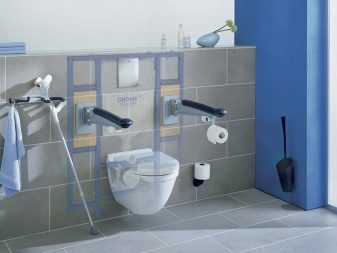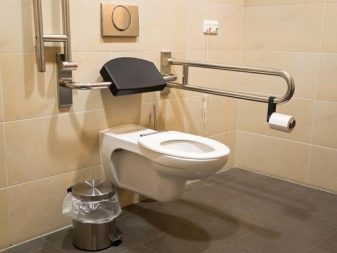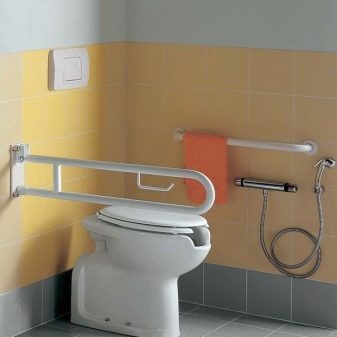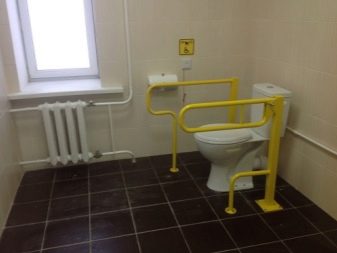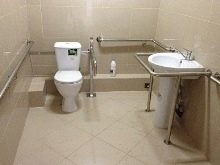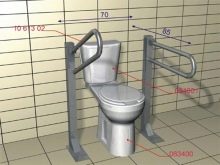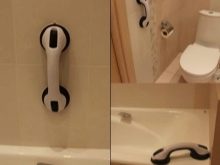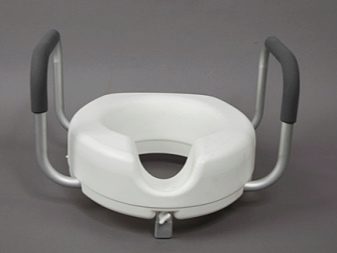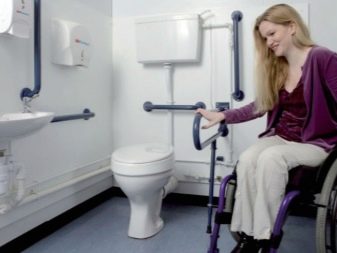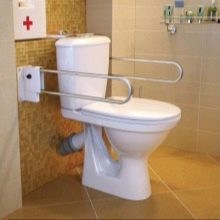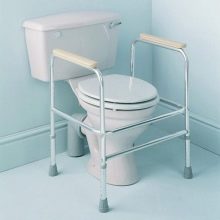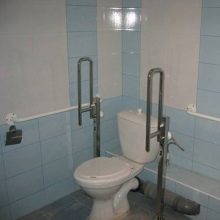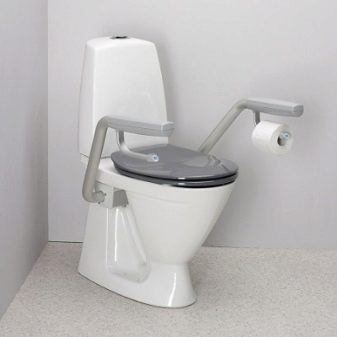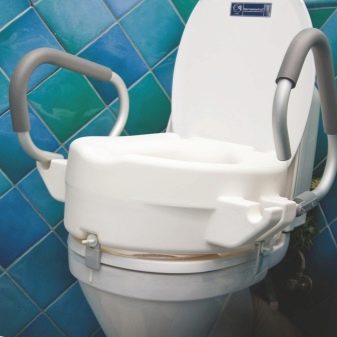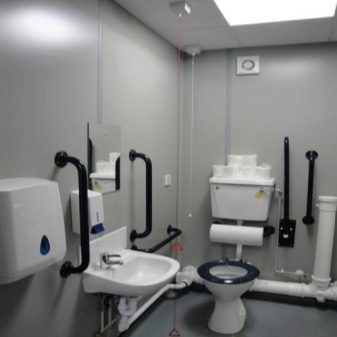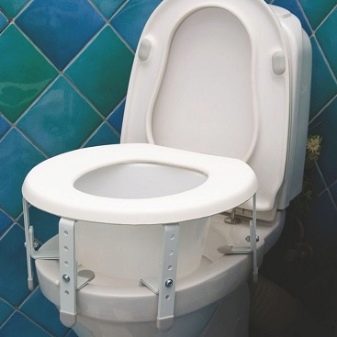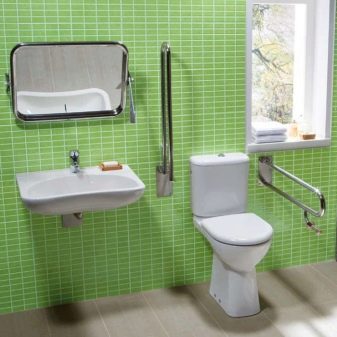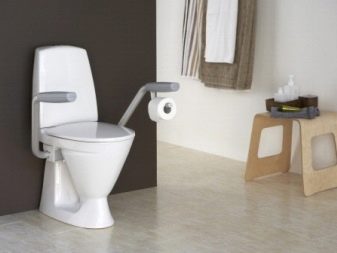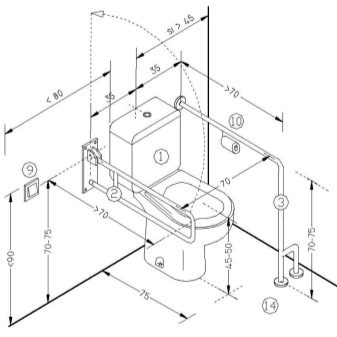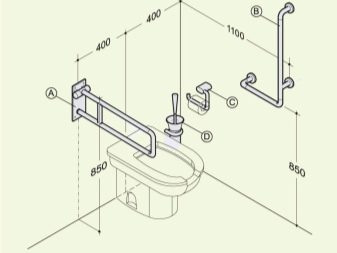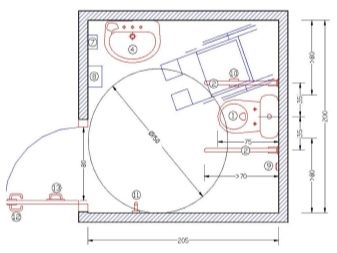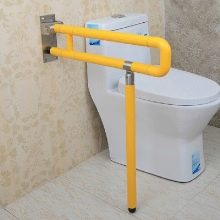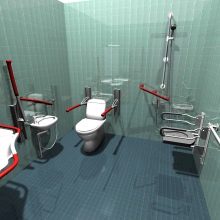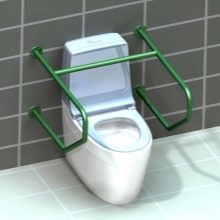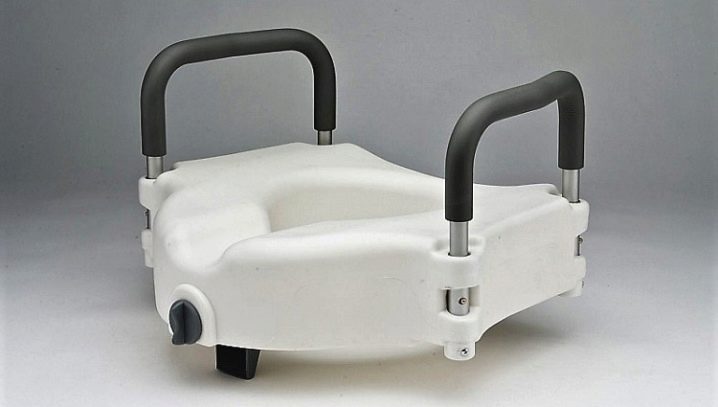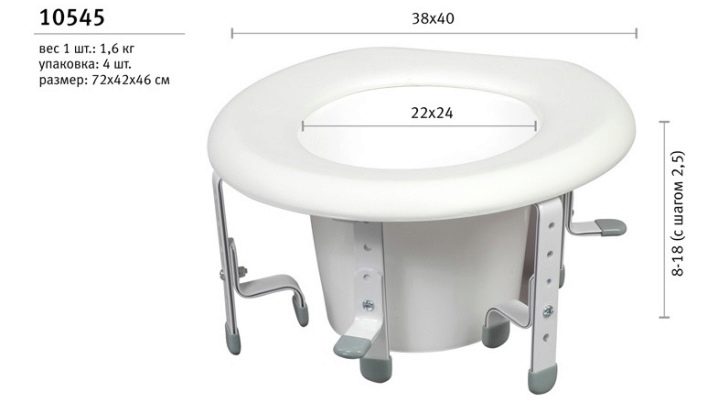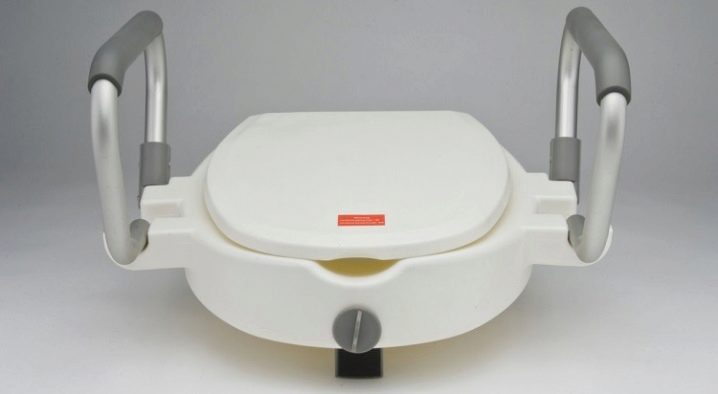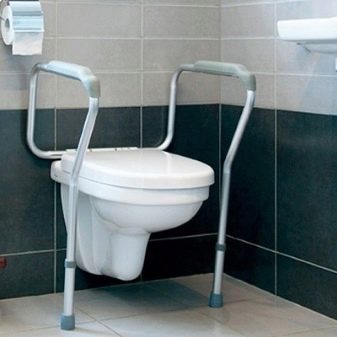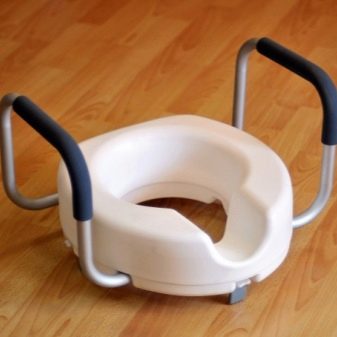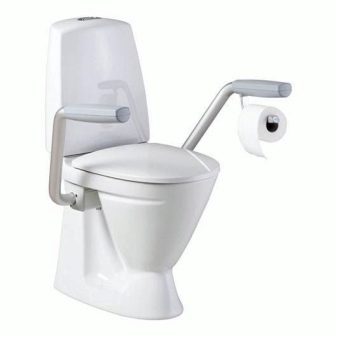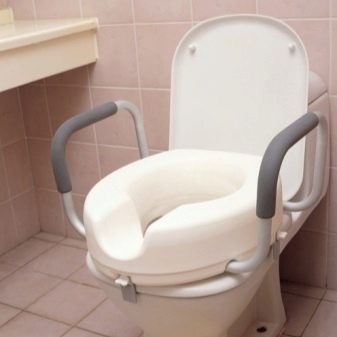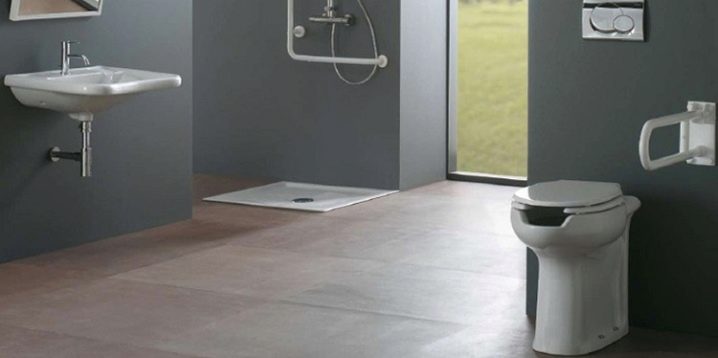Features of the toilet for people with disabilities

The bathroom and the plumbing used for people with disabilities should be special, in particular, be equipped with handrails and additional elements, have certain dimensions. This allows people with disabilities to carry out hygienic procedures on their own, without the help of other people.
Special features
Special toilets may be necessary not only for people with disabilities, but also for the elderly, as well as people leading a sedentary lifestyle due to certain diseases, including patients in the postoperative period.
The main requirement for the toilet for these groups of people is the requirement for height. Toilet bowls for people with disabilities 10-20 cm above normal models. If you buy a special (higher) toilet does not work, you can use special linings that allow you to get the required height of the device. The main thing in determining the height of the toilet bowl is how comfortable it is for the user to change from the chair to the toilet. The growth of the user is also taken into account, for example, it is difficult for a tall person with a problem of the musculoskeletal system to use a 45 cm toilet.
Another important element of special toilet bowls is handrails, support elements, and armrests. Their purpose is to help a person transfer from a wheelchair to a toilet. These elements are selected individually for a specific user. Depending on the type of fastening and application features, they can be of several types. More information about the advantages and disadvantages of specific types will be discussed below.
A toilet for a disabled person must comply with GOSTtherefore, before buying, check with the seller the availability of appropriate certificates.
GOST provides that the minimum distance from the toilet to the opposite wall (and more often the door) shouldmake up 60 cm
On both sides of the device there should be a free space of at least 25 cm.
Kinds
Depending on the type of installation, there are the following types of toilet bowls for people with disabilities:
- Stationary devices Preferred in large bathrooms, where there is the possibility of installing plumbing for healthy people (if they live with a disabled person) and space to accommodate fixed handrails, strollers;
- Device with folding handrails (move up-down and left-right) allows you to achieve ergonomic and user-friendly toilet;
- Device with removable handrails - portable version of the handles attached to the wall on the suction cups.
Most wheelchair users are not psychologically prepared to use other devices besides a special stationary toilet. Only it seems to them reliable and durable, so they strongly oppose other models.
Separately, it is necessary to allocate mobile toilet bowls, representing a portable chair or chair with a special compartment for waste products. They are equipped with a comfortable seat, armrests, sometimes - wheels.
As a rule, such devices are used to care for seriously ill patients and people with severe disorders of the musculoskeletal system.
Handrails can be of three types:
- stationary;
- mobile;
- folding.
They can all be attached to walls or floors. Mobile and folding are optimum for a bathroom of the small area.
Depending on the size of the bowl, toilet bowls for people with disabilities may be small (they are best used only if there is no possibility to buy a children's toilet), a compact size (the best option) or large ones.
Toilets for the elderly and disabled can be equipped with additional options, the most popular among which are the following.
- Hygienic cut-out and armrests attached to the toilet. The latter are equipped with holders for toilet paper.
- Adjustable armrests whose position is not connected to each other.
- Pads on the toilet allows you to adjust the height of the disabled. Such sidushka has the built-in hand-rail for more convenient and safe use. They consist of a directly hygienic base of suitable diameter, metal fasteners and clamps (changing their position, it is possible to change the height of the nozzle), as well as handrails.
- Automatically raised cover, heated seats, hygienic shower.
Material
The standard material for the manufacture of toilet bowls for the disabled is considered to be earthenware or porcelain. The first has a more affordable cost, but less service life. Both options are distinguished by reliability, environmental safety, ease of care.
If an option for public places is being considered, it is necessary that the device has anti-vandal characteristics. For these purposes, stainless steel toilets are optimal. In addition to increased strength properties, they are durable, easy to clean.
High reliability indicators are also provided by devices made of natural or artificial stone. In addition, they are durable, easy to clean (pollution practically does not stick to a perfectly smooth surface), have an attractive design.
However, it is impossible to find stone toilet bowls for people with disabilities on sale - they will have to be made to order, which increases the already considerable cost of the device.
Some manufacturers offer plastic models for people with disabilities. From such devices should be abandoned - they are unreliable.
As for the choice of handrails, the preference should be given made of anodized aluminum or chrome-plated stainless steel. Depending on the design, they are able to withstand weight up to 300 kg, are characterized by environmental friendliness, resistance to moisture.
Toilet bowls should be made of polymers. They withstand the weight of a person, but light enough. In addition, it is well suited for disinfection.
Dimensions
As already mentioned, the height of toilet bowls for people with disabilities is 10-20 cm higher than the height of conventional devices. The standard height of the toilet bowl is usually 40-45 cm, for disabled people - 50-60 cm. For wheelchair users, the optimum height of the toilet bowl is 50 cm, corresponding to the height of the wheelchair.
If you can not get a higher toilet, you can use special nozzles. They are removable (i.e. installed before each use) and fixed. The first option is suitable for those families that use one toilet, the second - if a person with disabilities has his own (usual) device.
Other parameters (width and length) of the bowl correspond to the usual ones.Standard toilet has a width of 35-38 cm, length 48-70 cm. For overweight people you can pick up large toilet bowls (depending on the size of the bowl, they are divided into small, standard and large). When choosing massive structures, make sure that they fit into the bathroom, and there is room for installing handrails and comfortable placement of the stroller in the toilet.
Colors
The traditional shade of sanitary ware is white, but today manufacturers offer color models that can be both soft pastel, rich and vibrant.
If we are talking about a user with poor eyesight, it is recommended to choose colored toilet bowls with bright contrast handrails. Colored toilets, among other things, can transform the interior, make it more cheerful, brighter. When choosing colored handrails, remember that they should give a disabled person a sense of security. That is why it is better to abandon the handrails of red, associative, perceived as the color of anxiety. Preference should be given to green, blue, orange shades.
When choosing a toilet with a colored ceramic coating should be prepared that it will require more care.Any drops and stains on it are clearly visible.
Nozzles and stands
If it is impossible to purchase a toilet for a disabled person, you can limit yourself to a special mobile cover, which is installed on a regular toilet. It has a hygienic surface in the shape of a circle and is height adjustable. Such a device is equipped with handrails and is easily removed after use. It is recommended to order lining according to individual sizes of the user. The advantages of toilet accessories are their versatility and low weight.
People suffering from diseases of the hip joints, recommended attachments maximum height (18-20 cm). They allow to reduce the distance between the hip joint and the toilet, removing the load from the first.
In the presence of excess weight, you can purchase wider nozzles that allow you to expand the width of the toilet bowl to 60 cm.
Often, patients who lead mostly recumbent, suffer from constipation and hemorrhoids.
In this case, it is better to choose a nozzle that provides hemorrhoidal nodes the desired position.
Extensions may have handrails (designed for use by people with severe foot and spinal pathologies) or nothave them (suitable for patients in the postoperative period, the elderly and people with excess weight). The handrails are wrapped in rubber, duroplast, or may have fabric inserts, which increases safety and makes them more convenient to use.
Among the useful devices - armrests. They reduce the load on the hands, allow you to "unload" the knees and lower back.
To make hygienic procedures more comfortable, as well as to reduce the time for their implementation, allow a bidet-top box.
How to choose?
Select the toilet should be based on the state of the user and living conditions. If the bathroom is small, and the disabled person or the elderly person lives with the family, it is wiser to use a standard toilet, equipping it with a special removable nozzle. In case of severe condition of the user and the ability to buy and place a special toilet for disabled people, of course, it is better to do so.
The height of the device must be chosen individually and be at least 50 cm from the floor. The most convenient and reliable from a psychological point of view are stationary handrails, however, if there is not enough space to accommodate them, you can choose any other option.
When choosing a lining for patients with severe dysfunction of the legs and spine, that is, for those who carry the main load on their hands, you should prefer lining with handrails. For patients after surgery or just elderly relatives, it is usually sufficient to lift the toilet without instructions.
Manufacturers and reviews
The most budgetary toilet models for people with disabilities are made in China and Taiwan, but more reliable and durable devices are German and American production.
Positive feedback is given to devices for the disabled in Finland. brand ido. They are distinguished by durability (achieved through the use of porcelain and high-quality fasteners), simple and reliable installation, a large selection of options for the placement of handrails, adjustable armrests, as well as the presence of a special coating that provides ease of care for the product.
The disadvantage is one - quite a high price.
Reliability and functionality demonstrate products from the German manufacturer Villeroy boch. The most popular are floor and suspension models with support handles, a seat with a microlift system, an integrated bidet.The manufacturer gives a guarantee on the toilet for a period of 5 years, provided that the installation is done by representatives of the official service center.
Toilets demonstrate high quality and affordability "A person" from domestic producer. Most models are high floor devices, handrails and other elements can be purchased separately from the same manufacturer. However, in the catalogs there are a lot of models with stationary and folding handrails.
According to user reviews, it is better to purchase devices with a microlift system, built-in hygienic shower or bidet. Of course, such toilet bowls are more expensive, but the higher price is justified by the comfort that their use gives.
Tips and tricks
Before you buy a toilet for a disabled person, you should carefully measure the toilet room and make sure that the chosen model takes a comfortable position in it, and there is enough space for all fixtures.
When purchasing a device, it is important to make sure that all the components are in stock.
Use optional accessories, such as anti-slip polyurethane overlays for handrails.
Each type of handrail has a maximum load for which it is designed.Before buying, read these options. When buying handrails for people suffering from arthritis, prefer curved. When using them, the load from the hands moves to the forearms.
At first glance, handrails with a corrugated surface more convenient. However, it should not be forgotten that in most elderly people the skin is very sensitive, therefore, a corrugated pattern of handrails can cause them discomfort.
You can find out how to install armrests on the toilet for disabled people from the video below.
